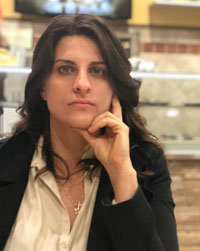“This Feels like Hope”
There has been a creative response to my invitation to share thoughts and observations about working with children and families during the pandemic.
The work that has been shared has taught me about the entity of the screen in treatment. How it adds to what we perceive, and takes away from it. How it becomes a presence in itself. How it changes presence and somehow relocates intersubjective space. The response has been so rich that the space of the Bulletin will not contain all of it. I will let you know where you will eventually be able to read more. For now, I am going to share two contributions.
I am choosing these two because they articulate how the communications of internal experiences among those of us that care for children are creating hope during our shared global crisis. As an American in a country that is now suffering a plague and being tested by fascist moves, I appreciate how the attentiveness and enlivening these clinicians express allow us to feel what heals during crisis, both in treatment and in our collegial communications.
Fabia Banella (Italy), who recently became Co-Chair of the IARPP Candidates Committee, shares some thoughts that recently emerged among candidates in their ongoing discussions:
We are all experiencing the power of disconnection during the pandemic, along with feelings of tiredness, confusion and vulnerability, as well as a new sense of intimacy with our clients. Now more than ever, we need to work while trying to gain efficacy in the new virtual realities and technological devices available. The work with families and children is affected (sometimes with the younger children, even more so) at multiple levels, and we need to find new creative ways to work on the relationships, all while missing — as early career therapists — a full (and maybe soothing) sense of knowledge and experience.
In these difficult moments, I can feel, more and more, a source of energy in the efforts to share our experiences and states of mind, and in the investment to co-create emotional connections, to keep alive hope and trust in our future.
Nupur Dhingra Pavia (India) depicts how each of our patients reacted differently to moving work online:
The resistant teenagers who had internal conflicts around ‘being seen’ were relieved. Some took the opportunity of distance to engage more, while some took the opportunity to disappear on us completely. Younger children with whom we had long-standing relationships were disappointed – they were clear that they missed the space, the books, the possibilities created in the room. Other young children, those who were more ambivalent or less articulate, enacted their preference by not showing up on the screen at all or being so detached it was clear they had zoned out.
The biggest challenge for our small, privately funded Child & Adolescent Mental Health Team [in New Delhi] was new patients. Suddenly, all the information we took in from the presence of the family-in-the-room was gone. Everyone was one-dimensional, disembodied and digital. We were lucky if sentences came through cleanly, without interruption or lag. Working with older teenagers, and working through issues of payment, communication and confidentiality with parents, led us into murky places which we had not previously had to consider. For a period of time, we stopped taking on young children altogether, while we learnt and un-learnt how to navigate this one-dimensional space of 11 inches.
I began to see parents online, without their children, in place of what would have been a joint first assessment meeting. I took the stance that parents were the experts on their children, living with them; they were best placed to intervene as well, since meeting in person was not possible. This followed in the footsteps of Freud with Little Hans and the Tavistock Clinic’s vast quantity of work with under-5’s.
Clear themes emerged in the parents’ concerns: behavior issues, increased anxiety, hyperactivity, children unable to get away from digital screens. I found myself very moved by the children’s plight, and what struck me most was how as a country we had made children’s emotional experience of being in lockdown invisible. The Indian media was focused on grave issues of mass migrations, hunger and poverty, and children featured only when school closures were discussed.
While parents could see that their children were perhaps responding to the increased anxieties around them, I had to remind the parents about the losses their children had incurred – social interaction in groups or a particular friend, outdoor play, physical movement, learning new skills, alternate attachment figures – the stuff we subsume as ‘school’ – where the latency age child uses up his or her fuel, and the teenager finds a symbolic home.
Once I empathized with the adult’s own emotional state, parents could imagine a conversation with their child. Acknowledging their losses, fears and the real uncertainty, the gap between their lived experiences shrunk.
Even after a single online consultation, most parents contacted me saying their child was calmer and they felt more capable of understanding and responding to them. This really highlights for me how the simplest act of acknowledging the other person’s internal emotional life validates it and is experienced as therapeutic. This feels like hope.
I thank Fabia and Nupur for sharing their experiences.
Ann Marie Sacramone (USA), Co-Chair




